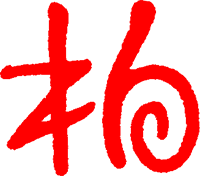「美大を出たらどういう活動をするのか」と訊かれることがある。おそらく風変わりなイメージをひたすら描き溜める私の試作行為が、グラフィックデザイナーやイラストレーターといった枠組みとうまく結びつきにくいのだろう。
私の美術の原体験として、印刷された平滑な絵が持つ洗練された美しさへの感動が根底にある。そこに結びついたのが、図版を分析的に眺める態度だ。物心ついた頃には「なぜこの図鑑の絵はリアルに見えるのか」といった疑問にたびたび思考を巡らせ、時には「なぜ漫画家によって顔の表現が異なるのか」という疑問から漫画ごとの造形要素を比較検討する遊びに時間を忘れることもあった。
美大進学後は、基礎課題をきっかけにシュルレアリスム絵画の奇抜な世界観と画家たちが採った手法との関連性に興味を抱く。卒業制作ではその〈遊ぶようにして描く〉手法に学び、ひたすら無目的に1,000枚のイメージを描いた。想定した結果に向かう描画から自己を解放し、イラストレーション表現の新たな可能性を模索したのだ。その成果をまとめた作品集には、以前の自分の表現にはなかった、現実に捕われない自由なデザインが活き活きと現れ出ていた。
大学院ではそのように生み出された非現実的なイメージとコミュニケーション・デザインとの接点を思索してきた。結果辿り着いたのが、膨大な無目的の試作からイメージを選び合成・加筆を重ね、一枚のイラストレーションを練り上げる行程である。博士後期課程では情報伝達イラストレーションにおける非現実的生体表現(論文中では〈異型〉と名付けた)の歴史的諸相を調査し、この行程を意義ある制作手法論として位置づけた。
私は博士論文の執筆によりようやく、子供時代から夢中になっていた〈絵の分析遊び〉にイラストレーション制作という大義名分を与えることができた。私は今後もこのように、考えながら描くことを続けていくだろう。
私の美術の原体験として、印刷された平滑な絵が持つ洗練された美しさへの感動が根底にある。そこに結びついたのが、図版を分析的に眺める態度だ。物心ついた頃には「なぜこの図鑑の絵はリアルに見えるのか」といった疑問にたびたび思考を巡らせ、時には「なぜ漫画家によって顔の表現が異なるのか」という疑問から漫画ごとの造形要素を比較検討する遊びに時間を忘れることもあった。
美大進学後は、基礎課題をきっかけにシュルレアリスム絵画の奇抜な世界観と画家たちが採った手法との関連性に興味を抱く。卒業制作ではその〈遊ぶようにして描く〉手法に学び、ひたすら無目的に1,000枚のイメージを描いた。想定した結果に向かう描画から自己を解放し、イラストレーション表現の新たな可能性を模索したのだ。その成果をまとめた作品集には、以前の自分の表現にはなかった、現実に捕われない自由なデザインが活き活きと現れ出ていた。
大学院ではそのように生み出された非現実的なイメージとコミュニケーション・デザインとの接点を思索してきた。結果辿り着いたのが、膨大な無目的の試作からイメージを選び合成・加筆を重ね、一枚のイラストレーションを練り上げる行程である。博士後期課程では情報伝達イラストレーションにおける非現実的生体表現(論文中では〈異型〉と名付けた)の歴史的諸相を調査し、この行程を意義ある制作手法論として位置づけた。
私は博士論文の執筆によりようやく、子供時代から夢中になっていた〈絵の分析遊び〉にイラストレーション制作という大義名分を与えることができた。私は今後もこのように、考えながら描くことを続けていくだろう。
I am sometimes asked, “What will you do upon graduation from art school?” Contemplating that query, I imagine that my experimental endeavors, and the constant stream of offbeat images produced therein, are unlikely to comprise a good fit with the frameworks expected of graphic designers or illustrators.
At the origin of my formative experiences with art lies inspiration triggered by the refined beauty of flat printed paintings. Leading me to that realization was the tendency to intently gaze into illustrations with an analytical eye. For as long as I can remember, in fact, my thoughts were stirred by the question of why illustrations in picture books appeared so real. At times, driven by the wonder of why means used to render facial expressions clearly differ by cartoonist, I literally forget the passage of time in lapsing into playfully comparative studies of the formative elements of specific cartoons.
After entering Tama Art University, encounters with fundamental themes spurred my interest in the relationships between the eccentric worldviews apparent in surrealist paintings and the methods adopted by those artists. For my graduate work, I devoted keen studies to such techniques (that is, depiction in a playful state of mind), feverishly drawing some 1,000 images with no particular goals in mind. This process liberated me from the drawing style aimed at reaching envisioned results, instead anxiously searching for new potential in the illustration expression genre. Emerging within the collection of works forming the results of that quest was the energetic and sparkling portrayal of what I consider to be enlightened designs unfettered by the shackles of realism.
In graduate school, I found myself engrossed in the linkage between improbable images fomented in this style and so-called “communication design.” This set me on the path of steady composition and revision of images arising from a massive volume of trial creations, likewise free of defined purpose, leading to the polished creation of each unique illustration.
At the doctoral level, I examined the historical phases of visionary biological expression portrayed in information transmission illustrations (referred to as “Strange Shapes” in my treatise), positioning that progression as a methodology of creation. Within the work of producing my doctoral dissertation, I at last succeeded in defining the legitimacy, in the form of illustrated creations, of the playful analysis of paintings that so absorbed me during my childhood years.
Going forward, I most certainly expect to often drift in this very same hazy mindset, as I carry on in my pursuit of the drawing craft.
At the origin of my formative experiences with art lies inspiration triggered by the refined beauty of flat printed paintings. Leading me to that realization was the tendency to intently gaze into illustrations with an analytical eye. For as long as I can remember, in fact, my thoughts were stirred by the question of why illustrations in picture books appeared so real. At times, driven by the wonder of why means used to render facial expressions clearly differ by cartoonist, I literally forget the passage of time in lapsing into playfully comparative studies of the formative elements of specific cartoons.
After entering Tama Art University, encounters with fundamental themes spurred my interest in the relationships between the eccentric worldviews apparent in surrealist paintings and the methods adopted by those artists. For my graduate work, I devoted keen studies to such techniques (that is, depiction in a playful state of mind), feverishly drawing some 1,000 images with no particular goals in mind. This process liberated me from the drawing style aimed at reaching envisioned results, instead anxiously searching for new potential in the illustration expression genre. Emerging within the collection of works forming the results of that quest was the energetic and sparkling portrayal of what I consider to be enlightened designs unfettered by the shackles of realism.
In graduate school, I found myself engrossed in the linkage between improbable images fomented in this style and so-called “communication design.” This set me on the path of steady composition and revision of images arising from a massive volume of trial creations, likewise free of defined purpose, leading to the polished creation of each unique illustration.
At the doctoral level, I examined the historical phases of visionary biological expression portrayed in information transmission illustrations (referred to as “Strange Shapes” in my treatise), positioning that progression as a methodology of creation. Within the work of producing my doctoral dissertation, I at last succeeded in defining the legitimacy, in the form of illustrated creations, of the playful analysis of paintings that so absorbed me during my childhood years.
Going forward, I most certainly expect to often drift in this very same hazy mindset, as I carry on in my pursuit of the drawing craft.

